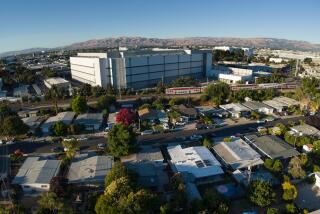It’s Impressive
- Share via
Three of the 11 science and technology centers created by the National Science Foundation are in California, an impressive recognition of the leading role played by scientists and engineers here. The winners emerged from 323 proposals. The recognition serves as a timely reminder of the importance of maintaining the institutions of the state with strong and visionary support.
The three centers in California will get $7 million initially, almost one-third of the entire initial national budget, and will be eligible for more federal support for as long as 11 years. At the heart of the program is a novel structure linking university researchers with those in other settings, including industry and national laboratories, in long-term basic research.
“One very important benefit we hope to see from this is a much shorter time span between actual discovery and utilization,” according to Erich Bloch, director of the National Science Foundation. “The fast transfer of knowledge is critical to our nation’s ability to compete in the world market.”
The largest of the initial grants to California institutions will be $3 million to Caltech to establish the Center for the Development of an Integrated Protein and Nucleic Acid Biotechnology. It will seek to accelerate research in protein and gene regulation at the very foundations of life. Leroy Hood, chairman of the biology division, will direct the program, using the most advanced genetic engineering, protein chemistry and data analysis. Caltech’s Jet Propulsion Laboratory scientists will work with on-campus scientists in the project.
In addition, Caltech will participate in a $4.1-million program at the Center for Research on Parallel Computation being established under the federal program at Rice University. The center will seek means of getting faster supercomputing performance by facilitating parallel processing--breaking computations into smaller problems that subsystems can process in parallel.
Two campuses of the University of California will be hosts to the other centers in this state. The Center for Quantized Electronic Structures is being established on the Santa Barbara campus with an initial grant of $2.1 million. It will explore novel concepts for producing extremely small structures in a new generation of compound semiconductors that might one day lead to very high-speed integrated circuits and to tiny lasers for use in fiber-optic circuits. The Center for Particle Astrophysics is being established on the Berkeley campus with an initial grant of $1.8 million. It will search for the dark matter that constitutes 90% of the mass of the universe but is invisible. Cooperating with Berkeley will be the UC campuses at Irvine and Santa Barbara, San Francisco State University, Stanford and the Lawrence Berkeley Laboratory.
It is no accident that three California institutions have been given this recognition. Caltech stands as an example of one of the greatest science and engineering institutions in the world--basically supported by private donations, supplemented by significant government research funds. The University of California, premier among state systems of higher education, has earned global recognition for the quality of its work made possible by a long tradition of generous public funding. The new federal funding program is a welcome acknowledgement of the importance of extensive public as well as private funding to advance basic research and technology, so essential to the economic and social vitality of the nation.






